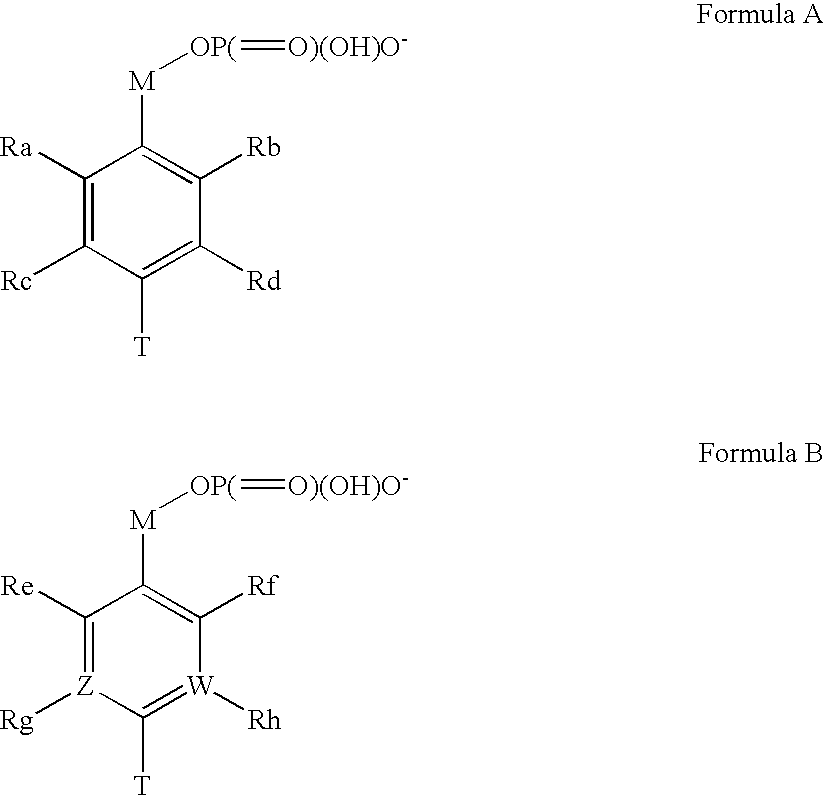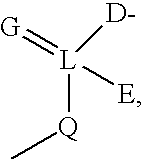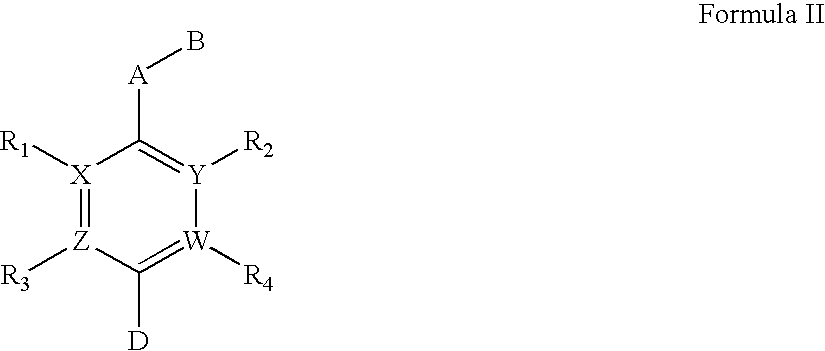Glycogen synthase kinase-3 inhibitors
- Summary
- Abstract
- Description
- Claims
- Application Information
AI Technical Summary
Benefits of technology
Problems solved by technology
Method used
Image
Examples
example 1
Determination of a 3D Structure of a GSK-3 Substrate by NMR Spectroscopy and Structure Calculations Based Thereon
[0417] Tested Peptides:
[0418] A small phosphorylated peptide patterned after the known GSK-3 substrate CREB, denoted p9CREB, and two additional peptides, a non-phosphorylated peptide, 9CREB, and a variant where S1 was replaced with glutamic acid (which is thought to mimic a charged group), 9ECREB, were used in these studies and are listed in Table I below.
TABLE 1PeptideSequenceSEQ ID NO:p9CREBILSRRPS(p)YR29CREBILSRRPSYR39ECREBILSRRPEYR4
[0419] Time course analyses of peptide phosphorylation by GSK-3 confirmed that only the phosphorylated peptide, p9CREB, was a substrate for GSK-3, while 9CREB and 9ECREB completely failed to be phosphorylated by GSK-3, thus indicating again that phosphorylated serine is an absolute requirement for GSK-3.
[0420] Determination of the 3D Structures of the Tested Peptides:
[0421] Determination of the 3D structures of p9CREB (FIG. 1a), 9CREB...
example 2
Chemical Syntheses of Mono Aryl / Heteroaryl GSK-3 Inhibitors (GSC Small Molecules)
[0430] Instrumental Data:
[0431] Proton, carbon, fluorine and phosphorus nuclear magnetic resonance spectra were obtained on either a Bruker AMX 500 spectrometer or a Brucker AV 300 spectrometer and are reported in ppm (δ). Tetramethylsilane (TMS) was used as an internal standard for proton spectra, phosphoric acid was used as an internal standard for phosphorus spectra and the solvent peak was used as the reference peak for carbon and fluorine spectra.
[0432] Mass spectra were obtained on a Finnigan LCQ Duo LC-MS ion trap electrospray ionization (ESI) mass spectrometer.
[0433] Thin-layer chromatography (TLC) was performed using Analtech silica gel plates and visualized by ultraviolet (UV) light, or by staining the plates in 0.2 wt % ninhydrine in butanol.
[0434] Elemental analysis was performed by Quantitative Technologies, Inc. (Whitehouse, N.J.).
[0435] HPLC analyses were obtained using a Hypersil B...
example 3
Activity Assays
Methods:
[0555] In vitro inhibition assays: Purified recombinant rabbit GSK-3β (Eldar-Finkelman et al., 1996) was incubated with peptide substrate PGS-1 (YRRAAVPPSPSLSRHSSPSQS(p)EDEEE) (SEQ ID NO:1) or peptide substrate p9CREB (SEQ ID NO:2) and with phenyl phosphate, pyridoxal phosphate (P-5-P), GSC-1, GSC-2, GSC-3, GSC-4, GSC-5, GSC-6, GSC-7 or GSC-21 (structural formulas are depicted in FIG. 3), at indicated concentrations. The reaction mixture included Tris 50 mM (pH=7.3), 10 mM MgAc, 32P[γ-ATP] (100 μM), 0.01% β-mercaptoethanol, and was incubated for 10 minutes at 30° C. Reactions were spotted on phosphocellulose paper (p81), washed with 100 mM phosphoric acid, and counted for radioactivity (as described in Eldar-Finkelman et al., 1996).
[0556] The effect of GSC-4, GSC-5 and GSC-7 (100 and 200 μM) on other protein kinases was tested by incubating CDK-2 (1 unit) with a reaction mixture similar to that described hereinabove and containing histone H1 substrate (5 μ...
PUM
| Property | Measurement | Unit |
|---|---|---|
| Fraction | aaaaa | aaaaa |
| Fraction | aaaaa | aaaaa |
| Fraction | aaaaa | aaaaa |
Abstract
Description
Claims
Application Information
 Login to View More
Login to View More - R&D
- Intellectual Property
- Life Sciences
- Materials
- Tech Scout
- Unparalleled Data Quality
- Higher Quality Content
- 60% Fewer Hallucinations
Browse by: Latest US Patents, China's latest patents, Technical Efficacy Thesaurus, Application Domain, Technology Topic, Popular Technical Reports.
© 2025 PatSnap. All rights reserved.Legal|Privacy policy|Modern Slavery Act Transparency Statement|Sitemap|About US| Contact US: help@patsnap.com



